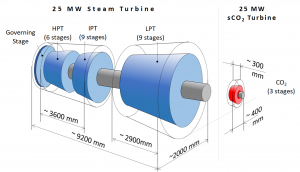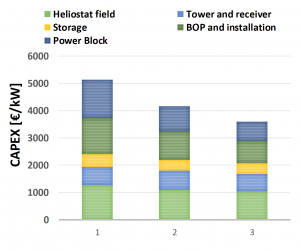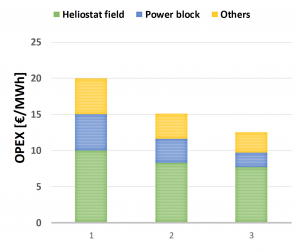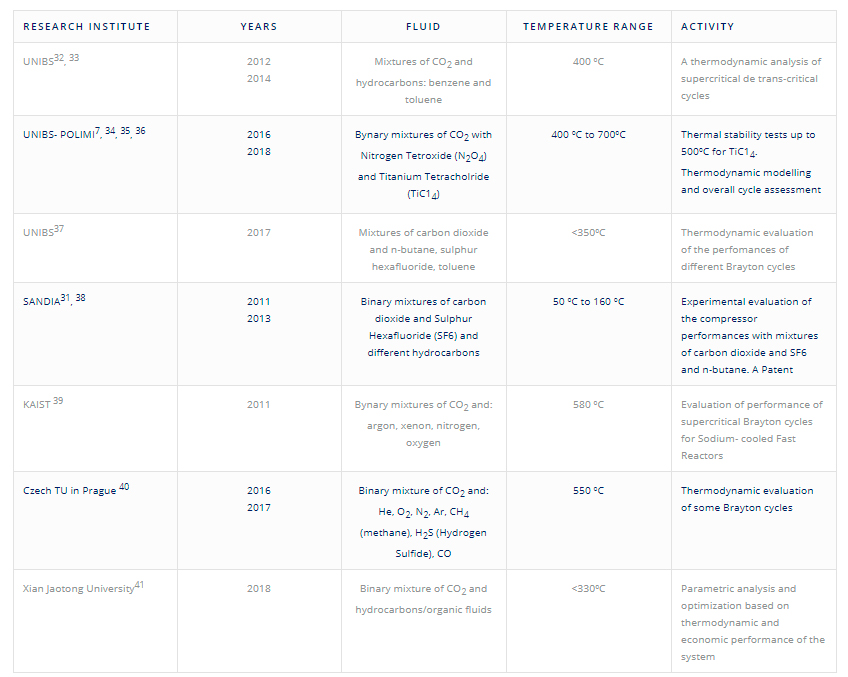CONCEPT AND AMBITION
Fundamentals features
Almost all concentrated solar power plants in operation worldwide adopt a conventional steam cycle for the conversion of thermal power into electricity, with just a few exceptions that are based on organic Rankine cycle (ORC) technology; nevertheless, these exceptions have a minor share of the total installed capacity since they have typical outputs in the order of a megawatt. More recently, supercritical CO2 (sCO2) technology has been identified as a potential major breakthrough in CSP applications, enabling a leap towards lower costs of solar thermal electricity. The potential of sCO2relies on the following features: (i) liquid or liquid-like (i.e. low compressibility) state of the working fluid during compression, which drastically reduces the associated work, and (ii) low expansion ratio of the cycle and low isentropic exponent of the working fluid (CO2), which largely increase the potential to recuperate heat within the cycle. The implementation of this concept would boost the performance of CSP plants but, at the same time, it poses significant technical challenges, the most relevant of which is achieving the very low temperature required at the start of the compression phase (to take the working fluid to liquid or liquid-like state). Indeed, the need to get close to the critical temperature of CO2 (31ºC) in a Brayton cycle embodiment, or even below it if a Rankine cycle is adopted (20ºC), makes it very difficult to attain and fully exploit the potential of the sCO2 cycle, particularly in typical CSP locations characterized by high ambient temperature and scarce water availability for cooling purposes.
To overcome this hurdle, some research groups proposed the addition of small quantities of selected compounds to the standard working fluid (pure CO2), yielding the so-called blended CO2, with the aim to raise the corresponding critical temperature and enable condensation at temperatures of 50°C to 60°C. The investigation of CO2 blends has mostly been carried out for geothermal and biomass applications to date, with maximum temperatures around 350-400°C. For these cases, results showed the potential of CO2-blends to increase the conversion efficiency by 30%.
Utilising these concepts, SCARABEUS moves the CO2 blend concept forward by developing mixtures which not only enable dry-cooled condensation in warm environments but can also withstand operating temperatures (at turbine inlet) up to 700ºC, hence tackling the two most influential factors affecting cycle efficiency.
Once the most appropriate CO2 blend is selected, the pseudo-supercritical temperature of the resulting working fluid can be increased notably (above 60ºC), which brings about the following key advantages over either steam or standard sCO2 cycles in parabolic trough and solar tower CSP plants:
- Condensing (Rankine) sCO2 cycles are enabled in typical CSP locations, thus boosting the net heat to electricity efficiency to above 50%;
- The complexity of the power block is largely reduced since only one recuperator and one primary heat exchanger are necessary as opposed to more than ten heat exchangers (six feed-water preheaters, one economizer, one evaporator, one super-heater, one re-heater) typically adopted in a steam cycle (see Figure 2, left).
- The size of turbomachinery is significantly reduced compared to steam turbines of similar power output (lower volumetric flowrate as shown in figure), bringing about a large reduction in capital costs.
A preliminary comparison between state-of-the-art solar tower plants using Solar Salts as heat transfer fluid (HTF) in the receiver and TES and other plant configurations based on supercritical CO2 is shown in the table below. Amongst the CO2-based layouts, results are given for pure and blended CO2 and for two different HTFs: Solar Salts and Sodium. The results show the outstanding performance achievable for blended-CO2
Comparison of state-of-the-art solar tower and afvanced solar tower plants using high temperatura HTFs and CO2 or CO2-blends as working fluids (the same heliostat fields and TES size is assumed in all cases).
| Steam | CO2 | CO2 + TiC14 | CO2 | CO2 + TiC14 | |
|---|---|---|---|---|---|
| HTF | Solar Salts | Solar Salts | Solar Salts | Advanced HTF | Advanced HTF |
| HTF Max. Temperature (ºC) | 565 | 565 | 565 | 715 | 715 |
| Receiver thermal power (MWth) | 189.38 | 189.38 | 189.38 | 187.72 | 187.72 |
| Receiver thermal efficiency (%) | 86.10 | 84.9 | 85.0 | 84.9 | 85.0 |
| Cycle efficiency (%) | 41.0 | 40.4 | 43.2 | 47.4 | 50.3 |
| Plant Auxiliary efficiency (%) | 98.8 | 96.3 | 96.9 | 96.0 | 96.5 |
| Plant net output (MWel) | 30.5 | 30.7 | 33.1 | 35.7 | 37.3 |
| Solar to electric efficiency (%) | 21.6 | 21.7 | 23.4 | 24.5 | 25.6 |
Economic features
The large potential for CAPEX and OPEX reduction targeted by SCARABEUS has been demonstrated by a preliminary economic assessment of the impact of adopting CO2 blends on the specific costs of the power block and the overall plant. The accompanying figure shows an economic comparison between the steam, pure CO2 and blended CO2 technologies for a reference power plant with 100 MWel output, obtained by well-referenced methodologies available in literature.
Economic assessment of different power block technologies when apllied to advanced CSP plants (Tmax = 700ºC)
AMBITION
Commercial techonology
Currently, there are two major technologies used in CSP power plants: parabolic trough and central receiver systems (towers). Parabolic trough collectors (PT) are dominant in terms of the total installed capacity. They incorporate a one-axis tracking system (linear solar collector) and, typically, make use of an intermediate heat transfer fluid based on synthetic oils flowing through a linear receiver, enabling peak operating temperatures slightly lower than 400ºC for a power block net efficiency of about 37-38%. Solar towers (ST) use heliostats to concentrate solar energy onto a central receiver. This enables higher concentration ratios and temperatures in the order of 550ºC, yielding a power block net efficiency of about 39-42%. Typically, molten nitrate salts are used as heat transfer fluid or steam is directly generated in the receiver. The former option (molten salt tower) is nevertheless preferred as it allows for the direct integration of high capacity thermal energy storage systems that enable a higher solar share or potentially continuous operation without fossil fuel backup.
Supercritical Carbon Dioxide power cycles and utilization of Co2 blends
Supercritical CO2 systems have been extensively researched in recent years, both theoretically and experimentally. In addition to this past analytical work, a number of loops have been constructed in the last ten years in order to demonstrate the feasibility of the concept. These loops are mostly based on the Recompression and Simple Recuperated cycle layouts, as shown in Table 7 where the main sCO2 facilities in operation or under construction today are listed.
Main supercritical carbon dioxide facilities in operation or under construction worldwide.
| Site of construction | Size | Power Cycle | Institution |
|---|---|---|---|
| West Mifflin, PA | 100 kWel | Simple recuperated | Bechtel Marine Propulsion Corporation Naval Nuclear Laboratory |
| Akron, Ohio | 7.3 MWel | Simple recuperated | Echogen (Ohio) |
| Albuquerque, New Mexico | 3.5 kg/s | Brayton cycle (without turbine) | SANDIA National Laboratories (New Mexico) |
| Arvada, Colorado | 20 kWel | Recompression | SANDIA-DOE-Barber Nichols (USA) |
| San Antonio, Texas | 1 MWel | Simple recuperated | SWRI & GE |
| Phoenix, Arizona | 10 MWel | Recompression | Sunshot Program |
| Ottawa, Canada | 35 kWel | Brayton cycle | Carleton Universtity (Canada) |
| Daejeon, South Korea | 10 kWel | Brayton cycle | KIER (South Korea) |
| Daejeon, South Korea | 80 kWel | Dual Simple Recuperated | KIER (South Korea) |
| Daejeon, South Korea | < 1 kWel | Transcritical CO2 | KIER (South Korea) |
| Tokyo, Japan | 10 kWel | Simple recuperated | Tokyo Institute of Technology (Japan) |
| Husinec-Rez, Czech Rep. | 0.35 kg/s | Recompression (without turbine) | Research Centre Rez (Czech Republic) |
| Stuttgart, Germany | not declared | Brayton cycle (only heat exchangers) | sCO2 Hero project partners |
| Wien, Austria | 0.35 kg/s | Simple recuperated | TU Wien |
The concept of employing CO2 blends to modify the critical properties of the working fluid dynamically has been explored in the past, mainly by Sandia National Labs in United States. This institution confirmed that adding a fraction of butane to the working fluid increases the critical temperature and, hence, cycle efficiency, whereas adding SF has the opposite effect (the critical temperature decreases). The proven concept was later protected under US Patent 20130033044A1 but, in spite of the evident interest in the concept and the successful experimental demonstration, no further activity has been reported in recent years. Moreover, the experimental activity carried out by Sandia focused on compressor performance near the critical point, but it did not verify the concept as a whole (i.e., the expected performance of the cycle using CO2 blends at high heat rejection temperatures) nor the stability of the working fluid at the high temperatures that are sought in sCO2 applications. Finally, the maximum temperature considered in this work was around 400 °C, as it aimed at geothermal and biomass applications only, and this is far from the temperatures sought in solar tower plants. Another innovative concept making use of CO2 mixtures in sCO2 power cycles at high pressure and temperature is the oxycombustion-based system developed by NetPower in collaboration with Toshiba, where a mixture of Carbon Dioxide and Steam (plus traces of other gases) is expanded in the turbine. Nevertheless, this concept is not aimed at modifying the critical point of the mixture but rather at achieving very high turbine inlet temperatures that would otherwise not be possible. Another important feature of the proposed technology is that it enables non-chemical, cost-effective carbon capture. Recently, Czech Technical University in Prague started to investigate the adoption of CO2 blends as working fluid for temperatures up to 550°C. The activity is theoretical and provides an estimation of the potential enhancement of power block performance due to the presence of additives. Previous and on-going research activities in the area CO2 blends undertaken by various research groups worldwide must be acknowledged. These are reported in Table 8.
Main supercritical carbon dioxide facilities in operation or under construction worldwide
At Politecnico di Milano and University of Brescia, the investigation of CO2 blends has been performed both from theoretical and experimental standpoints. Thus, cycle modelling is complemented with thermal stability tests to verify the maximum operating temperature of the fluid and Vapor-Liquid Equilibria (VLE) measurements to predict the thermodynamic properties of the mixture. While thermal stability for pure fluids such as TiCl4 was demonstrated at temperatures up to 650°C, other mixtures exhibited degradation at lower temperatures when they were investigated for utilization in ORC applications (350-400°C).
The previous section has set out the following challenges posed by CSP technologies globally:
I. Higher efficiencies must be achieved to enable a drastic reduction in the size and hence cost of the solar field, which is the main contributor to capital costs.
II. Higher operating temperatures are needed to bring about a drastic reduction of the size and hence cost of the storage system.
III. Operating flexibility is essential, which means being able to keep the two previous features regardless of the boundary conditions of the power plant (ambient conditions and load setting).
IV. Dispatchability is essential and the best way to accomplish it is through thermal energy storage systems which can be implemented easily at a competitive cost.
V. Ultimately, resolving the outlined challenges leads to a lower cost of electricity (LCoE), yielding a technology that becomes cost competitive against photovoltaic systems and even fossil fuel technologies. The target LCoE to achieve this twofold objective is in the range between 50 and 100 €/MWh.
VI. All these objectives are tackled by SCARABEUS, a project conceived to bring about greater strides than would be obtained if steam turbine or combined gas/steam turbine technologies were used. This progress is built upon the following innovations (a discussion about the specific innovations is provided in the next section):
a. Power block efficiency (i): SCARABEUS aims to demonstrate that 50% cycle efficiency is possible with the current state-of-the-art receiver technology. This objective will be achieved by the adoption of sCO2 power cycles with layouts tailored to the specific needs of CSP applications. The approach to cycle selection already used by USE has been recognised as innovative and with great potential in different scientific meetings within the sCO2 community.
b. Power block efficiency (ii): further to the utilization of sCO2 power cycles, SCARABEUS will make use of an innovative feature with regards to the working fluid. The utilization of CO2 blends ensures that the most efficient working cycles can be implemented in locations where ambient temperatures are unusually high (over 40ºC) and, moreover, it enables adapting the composition of the blend dynamically thus allowing the power block to run at its optimum point (peak efficiency) under varying boundary conditions.
c. Reliability: there has been some research with sCO2 cycles using CO2 blends in the past. Nevertheless, these investigations were either theoretical or with limited experiments only. Hence, the feasibility of the concept and the limitations that arise when operating the system in off-design conditions have not been verified to date, let alone considered any aspect of reliability (which is essential to achieving a higher TRL). With respect to previous research, SCARABEUS will validate the feasibility of the concept as a whole and explore different compounds amongst nonhydrocarbon species. Furthermore, SCARABEUS will verify that the proposed blends enable the adoption of very efficient condensation cycles at high ambient temperature and, it will also check the long-term thermal stability of the blends. This key innovation is considered of paramount importance to guarantee the reliability of the technology.
d. Cost of electricity: the aim of SCARABEUS is to reduce the LCoE by 50 €/MWh compared to the best available technology. This will come as a result of the 20% efficiency rise attained in the power block which enables a smaller footprint of both the solar field and thermal energy storage system (twofold cost reduction). The previous review of the state-of-the-art quoted a report by IRENA claiming that the LCoE of CSP is expected to drop down to 80-100 €/MWh by 2025 by improvements to all components including solar field, thermal storage and power block. This means that merging all the mentioned improvements to the solar field and receiver with the SCARABEUS power block (improvement by 20% with respect to sCO2 power block concept), it will be possible to produce fully dispatchable solar electricity at 60-75 €/MWh. Such a scenario will certainly make it possible to move forward towards a 100% renewable energy world.






